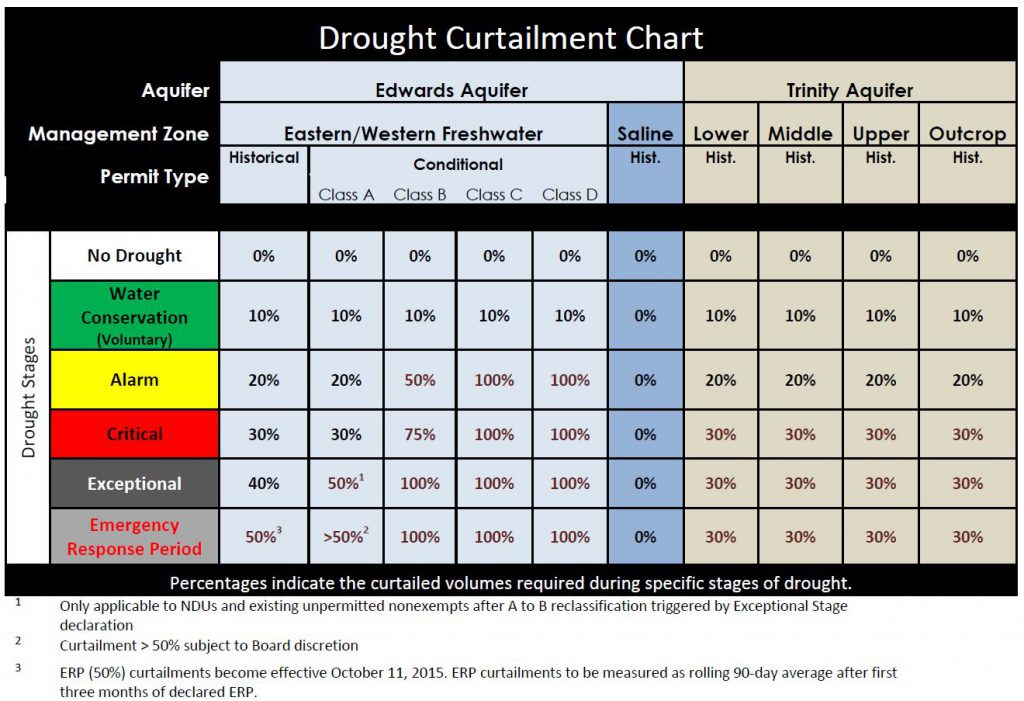To obtain a permit to pump water from the District, permittees are required to implement various conservation strategies. Permittees must agree to and follow guidelines to ensure they stay within their pumpage allotments and drought curtailments, both of which vary depending on the classification of the permit.
Pumpage Allotment
The District’s permit allotment for permittees is based on the agency’s drought trigger methodology. Pumpage reductions are determined by the permit type and the prevailing drought stage as outlined in the following table. If a permittee excessively and repeatedly violates the pumping curtailments, enforcement procedures can be implemented by the District and penalties may be assessed in accordance with the enforcement plan.
Below is the District’s Drought Curtailment Chart, which displays the required curtailments based on the aquifer, management zone, permit type, and drought stages the District is in.
Conservation and Drought Planning for Permittees
Depending on the permit classification, permittees must submit a User Conservation Plan (UPC) and/or a User Drought Conservation Plan (UDCP) along with a monthly pumpage chart. These documents outline the conservation practices the permittee will implement in and out of drought.
In accordance with District Rules, non-exempt well owners must develop a User Conservation Plan (UCP). The UCP outlines daily usage guidelines that, when followed, will maximize the utility of water withdrawn from the aquifer.
The UCP guidelines are implemented at all times and may only be replaced by more restrictive requirements as ordered by the Board under Stage IV or V drought.
A UCP includes:
- Ongoing conservation measures (everyday behavior, whether in drought or not)
- Recommended drought stage measures and action
- Drought stage curtailments
- Monthly drought curtailment chart (this gives permittees monthly goals for water use depending on the stage of drought)
In accordance with District Rules, non-exempt well owners must develop a User Drought Contingency Plan (UDCP). UDCPs enable permittees to manage their water system and water resources in a conscientious, fair, and appropriate manner during District drought stages when water use reductions are necessary.
Upon drought declaration, each permittee is required to implement the measures of their adopted User Drought Contingency Plans (UDCP) to achieve their mandatory pumpage reductions.
The intent of the UDCP is to set forth daily usage guidelines for outside of drought and in the three drought stages: Stage II Alarm Drought, Stage III Critical Drought, and Stage IV Exceptional Drought. The UDCP contains a description of activities for each drought stage and a chart of target monthly pumpage amounts based on seasonal trends of usage and authorized withdrawal amounts.
UDCPs include:
- Drought stage curtailments
- Requirements of drought stage notices and implementation to tenants and end users
- Declaration of alternate water sources
- Specific measures to take during each stage of drought
The monthly pumpage chart is the primary component of User Drought Contingency Plans (UDCP) that should be used for managing pumpage while in drought. This chart includes information on how much pumping is allowed each month and for each drought stage. It works by establishing a baseline pumpage volume for each month based on the typical usage distribution for specific types of wells (e.g. public water supply, irrigation, industrial). The 20%, 30%, and 40% curtailments are calculated from this baseline for Stage II Alarm, Stage III Critical, and Stage IV Exceptions Drought respectively.
For each month of the year, look at the corresponding column for the prevailing drought stage and the volume indicated is the maximum allowable pumpage for that month.
The sample chart below represents a fictitious public water supply system (Water-Mart WSC) with historical permitted pumpage of 10,000,000 gallons per year. In this example, the cell highlighted indicates the maximum amount of monthly pumpage for May during Stage II Alarm Drought. Please feel free to contact District staff if you need any assistance with your pumpage chart or any other component of your UDCP at eswanson@bseacd.org or (512)282-8441.
Monthly Permittee Pumpage During Drought
All Individual Product Permit permittees are required to submit monthly meter readings, which are used by the District to calculate the actual monthly pumpage volumes for each permittee. The District is then able to analyze whether permittees have met their required curtailments and target production volumes or if they overpumped.
The table below shows each month for the last five years and drought stage in effect at the time. You can view and download a drought analysis for each drought month. Each report includes all IPP permittees, their associated pumpage, and their drought compliance for that month.
If a permittee excessively and repeatedly violates the pumping curtailments, enforcement procedures can be implemented by the District and penalties may be assessed in accordance with the enforcement plan.

